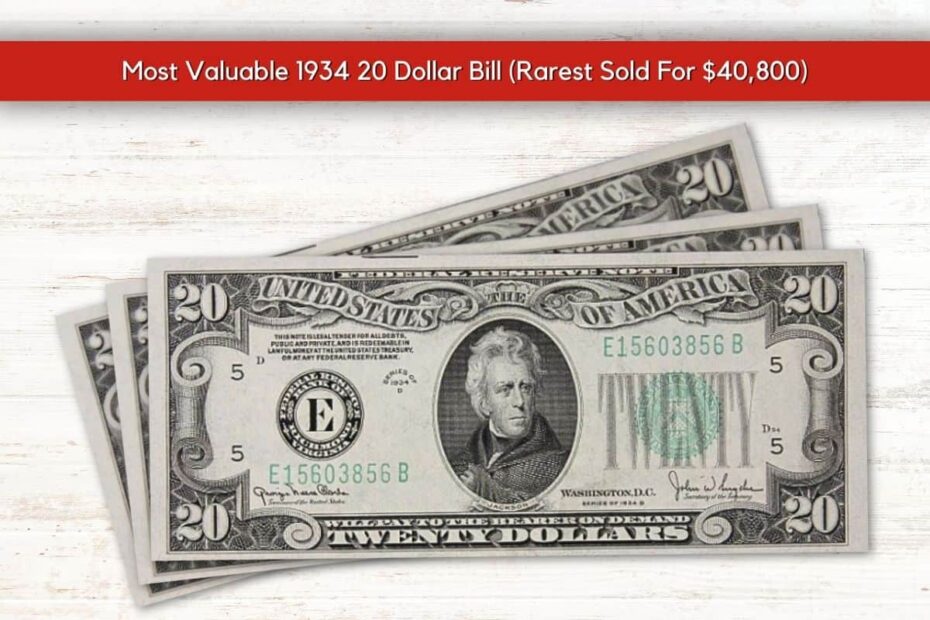Prologue: A Whisper from the Past
Imagine holding a piece of history in your hands – not just a mere piece of paper, but a tangible connection to a transformative era in American economic history. The 1934 $20 bill isn‘t just currency; it‘s a storyteller, a silent witness to one of the most challenging periods in our nation‘s financial landscape.
As a seasoned numismatist with decades of experience, I‘ve learned that every vintage bill carries a narrative far beyond its face value. The 1934 $20 bill represents more than monetary exchange – it symbolizes resilience, hope, and the intricate economic machinery that helped rebuild America during the Great Depression.
The Economic Crucible of 1934
To truly appreciate this remarkable piece of currency, we must first understand the tumultuous context of its creation. The year 1934 was a pivotal moment in American economic history. The United States was emerging from the devastating Great Depression, a period that had shaken the very foundations of financial stability.
President Franklin D. Roosevelt‘s New Deal policies were fundamentally reshaping the economic landscape. The Federal Reserve, recognizing the need for monetary reform, implemented significant changes in currency production and design. The 1934 $20 bill emerged as a testament to this transformative period – a symbol of economic recovery and governmental adaptation.
The Intricate Design: More Than Meets the Eye
When you first encounter a 1934 $20 bill, you‘re not just looking at a piece of paper. You‘re witnessing a masterpiece of design and security engineering. The bill features a portrait of Andrew Jackson, the seventh President of the United States, whose complex legacy mirrors the economic complexity of the era.
The intricate details – from the precise engraving techniques to the carefully selected color palette – reveal a meticulous approach to currency design. Each element was purposefully crafted to represent stability, strength, and the enduring spirit of American financial innovation.
The Hunt: A Collector‘s Passionate Pursuit
My journey into the world of vintage currency began decades ago, sparked by a chance encounter with a weathered 1934 $20 bill at a small antique shop in rural Pennsylvania. That moment transformed my understanding of collecting from a mere hobby to a profound passion.
Collectors like myself don‘t just accumulate objects; we preserve stories. Each bill represents a fragment of history, a tangible connection to a world that existed long before our time. The 1934 $20 bill, with its rich historical context, becomes more than a collectible – it‘s a portal to understanding our economic heritage.
Rarity and Valuation: The Collector‘s Calculus
Not all 1934 $20 bills are created equal. The value of these bills depends on a complex interplay of factors that go far beyond simple condition and preservation.
Series variations play a crucial role. The standard 1934 series, the Hawaii overprint notes (created in response to potential Japanese invasion during World War II), and star replacement notes each carry unique characteristics that dramatically influence their market value.
Condition is paramount. A bill that has survived seven decades with minimal wear can command prices that might surprise even seasoned collectors. While a typical circulated 1934 $20 bill might fetch $30-$250, exceptional specimens have sold for tens of thousands of dollars.
Authentication: The Detective Work of Numismatics
Authenticating a vintage bill is part science, part art. It requires a combination of technical expertise, historical knowledge, and an almost intuitive understanding of currency characteristics.
Professional collectors employ sophisticated techniques that go far beyond casual examination. Microscopic fiber analysis, precise seal verification, and detailed serial number cross-referencing form just part of the complex authentication process.
The Technological Edge
Modern technology has revolutionized currency authentication. Advanced spectral imaging, digital forensic tools, and comprehensive historical databases allow collectors to verify provenance with unprecedented accuracy.
Market Dynamics: The Evolving Landscape of Vintage Currency
The market for vintage currency is not static. It‘s a living, breathing ecosystem influenced by collector trends, economic conditions, and the ongoing narrative of historical preservation.
In recent years, we‘ve seen a surge of interest in Depression-era currency. Younger collectors are drawn to these artifacts not just as potential investments, but as tangible connections to a pivotal moment in American history.
Investment Potential
While passion drives most collectors, the investment potential of rare bills cannot be ignored. Exceptional 1934 $20 bills have appreciated significantly, with some specimens fetching six-figure prices at specialized auctions.
Preservation: Protecting Historical Artifacts
Preserving these delicate historical artifacts requires more than careful handling. It demands a holistic approach that combines scientific preservation techniques with a deep respect for historical integrity.
Specialized archival storage, controlled environmental conditions, and minimal handling are crucial. Each bill is not just a collectible – it‘s a historical document that deserves the utmost care and respect.
The Human Connection: Stories Beyond the Bill
What truly makes collecting vintage currency special is the human stories embedded within each piece. Every bill carries traces of countless hands that have held it, transactions it has facilitated, and dreams it has represented.
A Living Piece of History
The 1934 $20 bill is more than a collectible. It‘s a time capsule, a storyteller, a connection to a world that shaped our current economic reality.
Epilogue: The Ongoing Journey
As a collector, I‘ve learned that the true value of vintage currency extends far beyond monetary worth. It‘s about preserving stories, understanding our collective history, and maintaining a tangible connection to the generations that came before us.
The 1934 $20 bill stands as a testament to human resilience, economic innovation, and the enduring power of storytelling through material artifacts.
Disclaimer: Values and market conditions are dynamic and subject to change. Always consult professional numismatists for current valuations and authentication.
